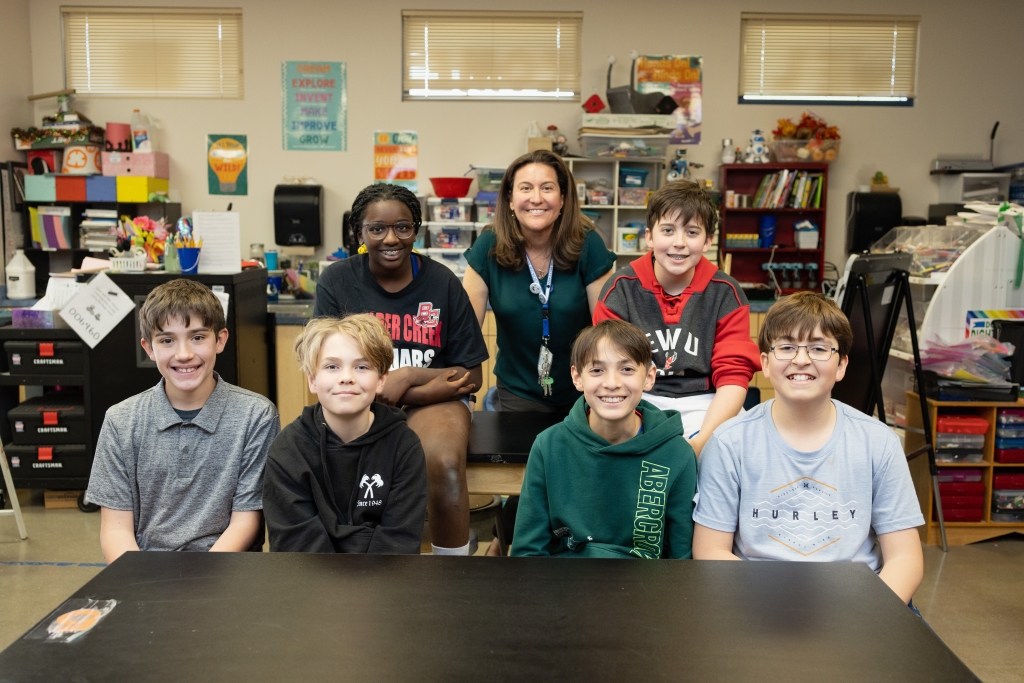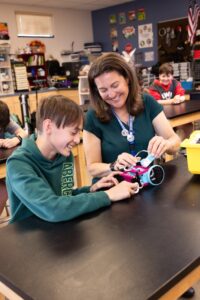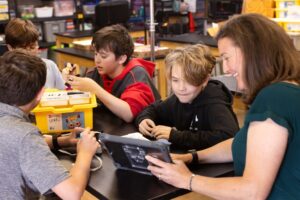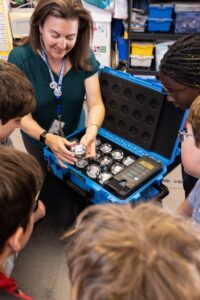Schoolhouse Tech!

Writer Shannon Severson // Photography by Loralei Lazurek



Technology seems to be woven into every aspect of life these days. Sometimes it makes life more convenient, and at other times it can be frustrating. Most of us have had to learn and adjust to each new development as it has advanced — from the advent of home computers to the connectivity of the internet and the ubiquity of smartphones.
Gen Alpha, on the other hand, has never known a world without the presence of technology. Canyon Springs STEM Academy in Anthem is creating a complete curriculum and educational experience that combines the best of science, technology, engineering and mathematics and incorporates it into every facet of grades pre-K through 8.
Jaime Hansen is the STEM specialist at Canyon Springs, a native of Cave Creek, and a Northern Arizona University graduate with 17 years of teaching experience. She’s brought her vision, creativity and talent for procuring adequate grant funding to help develop this program and its students to their fullest potential. Canyon Springs STEM Academy has been in partnership with Northern Arizona University since 2012 to promote STEM and STEM education in the classroom.
Hansen’s dedication and success have earned her accolades as Deer Valley Unified School District Teacher of the Year for 2021–22 and Rotary Teacher of the Year for 2018–19.
“When I began working at Canyon Springs in the gifted kindergarten classroom 10 years ago, STEM was a concept drawing attention,” Hansen recalls. “It was new to get tech embedded into education, but we really didn’t know how to integrate it. I learned through training and experience of finding how STEM could be supported in learning standards. The kids loved it. They embraced it. They love STEM. Their reaction encouraged me to do more. They were so invested.”
Her efforts, combined with those of the STEM Professional Learning Community team at Canyon Springs, are a major factor in the school’s recent STEM recertification award from Cognia STEM Certification. The Cognia Global Commission is a nonprofit working in more than 80 countries, and its STEM certification is highly prized. Fewer than 400 institutions worldwide have received this certification that indicates the highest dedication to STEM education and a commitment to building awareness in the community.
“The reviewers said that we have outshined any other school that has been recertified,” Hansen points out.



Hands-On in the Makerspace
One of the primary qualities of the STEM-focused education at Canyon Springs is “problem-based learning” and infusing it into every aspect of a child’s day.
That’s where Hansen’s position shines, and she says the job is a bit of a unicorn. Not many educators get to have STEM as their primary focus in both the classroom, the school’s makerspace and its Renaissance program that serves highly gifted students.
She was recently chosen to attend the International Society for Technology in Education conference in Philadelphia.
“It was wonderful,” Hansen says. “Tech is ever-changing. There’s always something new happening, especially with AI. You have to stay one step ahead. [Deer Valley Unified School District K-12 instructional technology manager], and I spent time learning, collaborating and bringing that experience back to our campus. There were so many opportunities to learn about tech in the classroom, and I [was inspired to] write a grant for esports through SRP.”
Back in Anthem, the makerspace is a classroom dedicated to STEM and the engineering design process. Materials on hand range from Popsicle sticks to robotics components. As literacy is also embedded in the program, there’s a library of books she’s collected with stories to inspire exploration. A Humpty Dumpty book, “After the Fall,” prompted the creation of egg drop devices, for example. Hansen says starting with a book gets kids thinking inquisitively. The students learn problem-solving and critical thinking skills by applying STEM concepts.
“I became the STEM specialist three years ago and helped to create the Makerspace,” Hansen says. “You’d be amazed by the amount of materials I’ve accumulated in those years. When I taught fifth grade, I began grant writing and reached out to entities like SRP, the Phoenix Suns and Arizona Diamondbacks; everyone jumped on to support us. They saw the importance of STEM, too. We’ve also received many donations from our community, and our PTSA is extremely supportive with raising funds. A certain percentage of those funds goes to the Makerspace and STEM education.”
Hansen says she’s thankful for the dedication of the school and school district administration to STEM education. It’s gratifying to be able to fulfill teacher requests for materials that promote STEM and engineering in the classroom, which can often be expensive.
“I’m glad they see the value of that investment because, truly, every grade level will come to me at some point with materials or things they need,” Hansen says. “I feel like I can empower them with what I’m able to provide. It almost brings tears to my eyes because I’ve heard of situations where that’s not the case at other schools.”
The youngest students enjoy Sphero Indi, coding robots that can be programmed using colored tiles. In third grade, Lego Essential kits continue the foundations, which are often the building blocks of computer coding. Canyon Springs also sponsors a FIRST LEGO League robotics team, which students in grades six through eight can join and participate in FIRST LEGO League competitions.
In middle school, STEM electives utilize RVR and VEX robots to extend coding knowledge, opening the door to learning JavaScript. Boulder Creek High School’s engineering program stays in contact with Hansen and Canyon Springs and is ready to welcome STEM-educated students into high school-level programs and an engineering club.



Collaboration: Classroom and Community
So how does the STEM focus manifest in everyday classroom activities?
Hansen describes a first-grade classroom studying animal habitats using picture books and simple nonfiction with plans to create dioramas as a science and art project. The teacher asked Hansen how she could extend the lesson plan in the Makerspace. The children used iPads to create stop-motion animations of their dioramas.
“Once the children had completed the creation of their clay animals in art class, they came into the Makerspace,” Hansen says. “They made stop-motion videos of their clay figure eating or swimming, or a little sloth going up and down a tree. It was truly adorable and such a perfect collaboration of efforts. [The children] were invested — hook, line and sinker. They were so into it.”
A QR code was created so families visiting for a gifted night could scan the code and view the videos produced by each child.
In the middle school grades, Hansen cites another animal-centric project where the Renaissance students were researching organizations that focus on animal rehabilitation. The students used Tinkercad software for the 3D printers in the makerspace to design and produce animal prosthetics. Visitors to the school’s STEM night were able to view the prosthetics.
Hansen and the Canyon Springs team are dedicated to community engagement, a vital element to Canyon Springs’ Cognia certification. Each fall, a STEM Career Day is held to connect students and STEM industry representatives. Each spring, the school invites the entire community to visit Canyon Springs Family STEM Night. There are lessons for grades K-4 and 5-8, and families are encouraged to explore the campus.
In February, more than 1,100 people attended STEM Night. Two flyovers by the Phoenix Police Department SWAT team and Civil Air Patrol (carrying the assistant principal, Mrs. Talley) zoomed overhead as families experienced how the school incorporates core concepts into every classroom.
Hansen credits the leadership and volunteerism of the school’s chief science officers as playing a huge role in the event’s success. More than 20 students serve as chief science officers, a student organization for grades five through eight that provides an avenue for those passionate about STEM to promote the concepts in the classroom.
“They are incredible,” Hansen says of the group. “We couldn’t have STEM night be what it is without them. We meet every other week in the makerspace in the early morning before school. We have student officers; the president creates an agenda, and the expectation is that they come in with ideas, solutions and an open mind.”
The chief science officers help run stations during big events, gather materials, give presentations and create STEM-focused lessons that they teach to the younger grades. The program, which began with just five students, is growing each year.
Hansen says she also benefits from a Professional Learning Community with STEM teachers from around the district.
“We meet and talk and share ideas,” Hansen says. “Our focus is the same, and it keeps tabs on the pulse of the STEM community. We are all focused on the engineering design process. We are each other’s cheerleaders and lend support to each other.”
Just as STEM careers in the work world depend on collaboration of many bright minds, so does building a top-rated STEM education for students. The Deer Valley Unified School District Technology Division has begun rolling out big tech pieces, including curriculum-based computer science technology pieces by grade level to support computer science standards.
Hansen says this support from Canyon Springs administrators, district leadership, fellow teachers, families, students and the community has combined to produce something very special. Young people who are encouraged to reach their potential from the first time they step foot in a classroom are destined to do great things for the world when they enter the workforce someday.
“We have such a supportive system,” she explains. “STEM is truly embedded in everything; it’s in all that we do here.”

